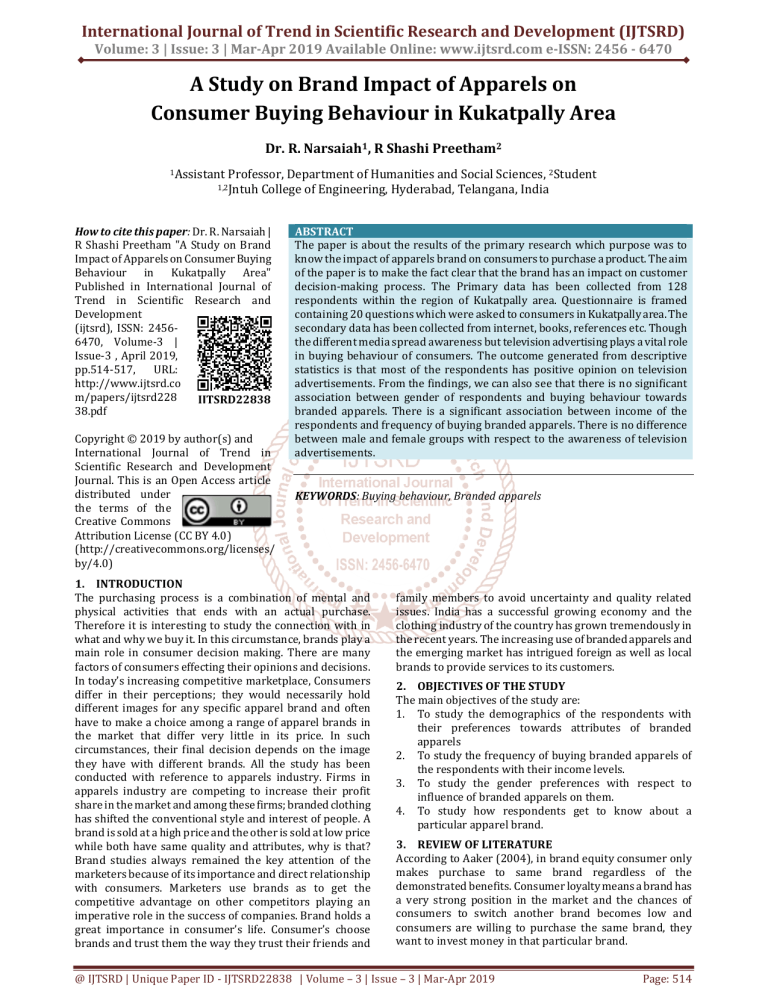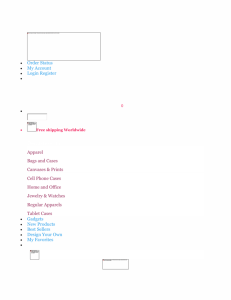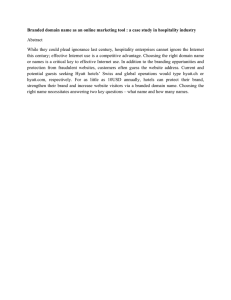
International Journal of Trend in Scientific Research and Development (IJTSRD)
Volume: 3 | Issue: 3 | Mar-Apr 2019 Available Online: www.ijtsrd.com e-ISSN: 2456 - 6470
A Study on Brand Impact of Apparels on
Consumer Buying Behaviour in Kukatpally Area
Dr. R. Narsaiah1, R Shashi Preetham2
1Assistant
Professor, Department of Humanities and Social Sciences, 2Student
1,2Jntuh College of Engineering, Hyderabad, Telangana, India
How to cite this paper: Dr. R. Narsaiah |
R Shashi Preetham "A Study on Brand
Impact of Apparels on Consumer Buying
Behaviour in Kukatpally Area"
Published in International Journal of
Trend in Scientific Research and
Development
(ijtsrd), ISSN: 24566470, Volume-3 |
Issue-3 , April 2019,
pp.514-517,
URL:
http://www.ijtsrd.co
m/papers/ijtsrd228
IJTSRD22838
38.pdf
Copyright © 2019 by author(s) and
International Journal of Trend in
Scientific Research and Development
Journal. This is an Open Access article
distributed under
the terms of the
Creative Commons
Attribution License (CC BY 4.0)
(http://creativecommons.org/licenses/
by/4.0)
ABSTRACT
The paper is about the results of the primary research which purpose was to
know the impact of apparels brand on consumers to purchase a product. The aim
of the paper is to make the fact clear that the brand has an impact on customer
decision-making process. The Primary data has been collected from 128
respondents within the region of Kukatpally area. Questionnaire is framed
containing 20 questions which were asked to consumers in Kukatpally area. The
secondary data has been collected from internet, books, references etc. Though
the different media spread awareness but television advertising plays a vital role
in buying behaviour of consumers. The outcome generated from descriptive
statistics is that most of the respondents has positive opinion on television
advertisements. From the findings, we can also see that there is no significant
association between gender of respondents and buying behaviour towards
branded apparels. There is a significant association between income of the
respondents and frequency of buying branded apparels. There is no difference
between male and female groups with respect to the awareness of television
advertisements.
KEYWORDS: Buying behaviour, Branded apparels
1. INTRODUCTION
The purchasing process is a combination of mental and
physical activities that ends with an actual purchase.
Therefore it is interesting to study the connection with in
what and why we buy it. In this circumstance, brands play a
main role in consumer decision making. There are many
factors of consumers effecting their opinions and decisions.
In today’s increasing competitive marketplace, Consumers
differ in their perceptions; they would necessarily hold
different images for any specific apparel brand and often
have to make a choice among a range of apparel brands in
the market that differ very little in its price. In such
circumstances, their final decision depends on the image
they have with different brands. All the study has been
conducted with reference to apparels industry. Firms in
apparels industry are competing to increase their profit
share in the market and among these firms; branded clothing
has shifted the conventional style and interest of people. A
brand is sold at a high price and the other is sold at low price
while both have same quality and attributes, why is that?
Brand studies always remained the key attention of the
marketers because of its importance and direct relationship
with consumers. Marketers use brands as to get the
competitive advantage on other competitors playing an
imperative role in the success of companies. Brand holds a
great importance in consumer’s life. Consumer’s choose
brands and trust them the way they trust their friends and
family members to avoid uncertainty and quality related
issues. India has a successful growing economy and the
clothing industry of the country has grown tremendously in
the recent years. The increasing use of branded apparels and
the emerging market has intrigued foreign as well as local
brands to provide services to its customers.
2. OBJECTIVES OF THE STUDY
The main objectives of the study are:
1. To study the demographics of the respondents with
their preferences towards attributes of branded
apparels
2. To study the frequency of buying branded apparels of
the respondents with their income levels.
3. To study the gender preferences with respect to
influence of branded apparels on them.
4. To study how respondents get to know about a
particular apparel brand.
3. REVIEW OF LITERATURE
According to Aaker (2004), in brand equity consumer only
makes purchase to same brand regardless of the
demonstrated benefits. Consumer loyalty means a brand has
a very strong position in the market and the chances of
consumers to switch another brand becomes low and
consumers are willing to purchase the same brand, they
want to invest money in that particular brand.
@ IJTSRD | Unique Paper ID - IJTSRD22838 | Volume – 3 | Issue – 3 | Mar-Apr 2019
Page: 514
International Journal of Trend in Scientific Research and Development (IJTSRD) @ www.ijtsrd.com eISSN: 2456-6470
According to Keller (2003), the fact that consumers purchase
the same brand continuously is not brand loyalty. They just
do it because of their common habits that don’t change or
they are being attracted by purchase offers or any other
promotional tool.
According to Driessen (2005), companies can create strong
brand image and recognition through advertisement. He
explained that by advertisement, companies try to target
teenagers and youth. They are attracted towards traditional
advertisement more easily than adults those who are
mature. They show positive reaction and quick reaction to
the company’s advertisement. Older person has more
purchasing experience than younger one.
4. METHODOLOGY
This study is based on the primary data collected through a
sample of 128 people. The questionnaire was constructed to
understand the impact of branded apparels on consumer
buying behaviour. The data was collected through a survey
along with the detailed demographics of the participants.
Secondary data was collected from various sources such as
books, journals, and online resources. This questionnaire
was distributed to 128 people in Kukatpally area. So the final
sample size is 128. The questionnaire was sent by e-mail and
What’s app contacts in the form of Google forms. The
completed questionnaire was sent back through email and
responses were updated in Google forms. Hyderabad is a
place where we can see people with different cultures and
customs. Since Hyderabad is technically developed, research
is conducted in this area. It is conducted using quantitative
as well as qualitative method. Quantitative data is collected
with the help of questionnaire. The data collected from the
questionnaire is analysed using the mathematical tools and
the result is presented in tables for clear understanding to
the reader. The conclusions are drawn from the findings. The
collected data are logically and systematically entered using
SPSS software and analysis done as per the requirement of
study. Descriptive analysis is done for analysing the data.
Central tendency, frequency table, Chart, Graph and Chisquare are used for descriptive analysis. Whereas
Hypothesis testing, Chi-square test, t-test are done for
internal analysis.
5. RESEARCH HYPOTHESIS
1. Null Hypothesis (H0): There is no significant association
between age and attributes while selecting branded
apparel.
Alternative Hypothesis (H1): There is a significant
association between age and attributes while selecting
branded apparel.
2.
3.
Null Hypothesis (H0): There is no difference between
male and female groups with respect to influence of
branded apparels on buying behaviour.
Alternative Hypothesis (H1): There is a difference
between male and female groups with respect to
influence of branded apparels on buying behaviour.
6. DATA ANALYSIS AND INTERPRETATION
6.1 Demographic profile of respondents
Figure 1: Age analysis
Figure 2: Gender analysis
a.
Descriptive statistics:
Figure 3: Frequency of buying
Null Hypothesis (H0): There is no significant association
between income of the respondents and frequency of
buying branded apparels.
Alternative Hypothesis (H1): There is a significant
association between earnings of the respondents and
frequency of buying branded apparels.
Figure 4: Attributes of respondents while
choosing a branded apparel
@ IJTSRD | Unique Paper ID - IJTSRD22838 | Volume – 3 | Issue – 3 | Mar-Apr 2019
Page: 515
International Journal of Trend in Scientific Research and Development (IJTSRD) @ www.ijtsrd.com eISSN: 2456-6470
6.2 Cross tabulation analysis
6.2.1 Cross tabulation of age and attributes while selecting a branded apparel
Age
15– 20 20– 25 25– 30 Above 30
Quality
16
77
4
7
Cost
12
58
3
3
Durability
6
59
4
3
Availability
6
36
1
3
Total
18
97
6
7
Table 1: Cross Tabulation of age and attributes While selecting a branded apparel
Attributes while selecting a branded apparel
6.2.2
Total
104
76
72
46
128
Cross tabulation of income of respondents and frequency of their buying branded apparels
Frequency of buying
Income level
Total
Monthly Occasionally Weekly Yearly
Less than 15000
2
19
0
1
22
15000 – 20000
0
7
0
0
7
20000 – 50000
4
12
2
0
18
Greater than 50000
8
8
0
0
16
No income
10
49
4
2
65
Total
24
95
6
3
128
Table 2: Cross tabulation of income of respondents and frequency of their buying branded apparels
b. Chi square analysis
6.3.1
Analysis of age and attributes while selecting branded apparels
Here, the analysis covers all the statistical analysis made to verify the hypothesis and ascertain the significance of age and
attributes while selecting branded apparels.
Pearson Chi-Square Tests
Age
Chi-square 11.445
Attributes while selecting branded apparels
df
12
Sig.
0.491
Table 3: Analysis of age and attributes while selecting branded apparel
We can see that as the chi- square value (0.491) is greater than 0.05 level of significance. Therefore we accept the null
hypothesis and we can conclude that there is no significant association between age and attributes while selecting branded
apparel.
6.3.2 Analysis of income of respondents and frequency of their buying branded apparels
Here, the analysis covers all the statistical analysis made to verify the hypothesis and ascertain the significance of income of
respondents and frequency of their buying branded apparels
Value df Asymptotic Significance (2-sided)
Pearson Chi-Square 19.285 20
0.046
Likelihood Ratio
20.808 20
0.049
N of Valid Cases
128
Table 4: Analysis of income of respondents and frequency of their buying branded apparels
We can see that as the chi- square value (0.046) is less than 0.05 level of significance. Therefore, we reject the null hypothesis
and accept alternate hypothesis. Hence, we can conclude that there is a significant association between income of respondents
and frequency of their buying branded apparels.
6.4 Independent t- test
6.4.1
Analysis of the gender and influence of apparels brand on buying behaviour
Here, the analysis covers all the statistical analysis made to verify the hypothesis and ascertain the significance of gender and
influence of apparels brand on buying behaviour.
Group statistics
Gender
N
Mean
Std. Deviation
Std. Error Mean
Male
79
1.608
0.4914
0.0553
Female 49 1.673
Table 5: Group statistics
0.4738
0.0677
Influence of apparels brand on buying behavior
@ IJTSRD | Unique Paper ID - IJTSRD22838 | Volume – 3 | Issue – 3 | Mar-Apr 2019
Page: 516
International Journal of Trend in Scientific Research and Development (IJTSRD) @ www.ijtsrd.com eISSN: 2456-6470
Independent samples test
Levene's Test for
Equality of Variances
Influence of
apparels
brand on
buying
behaviour
Equal variances
assumed
t-test for Equality of Means
F
Sig
t
df
Sig.
(2 tailed)
Mean
difference
Std. error
difference
2.409
0.123
- 747
126
0.456
-.0659
0.0882
- 754
104.729
0.453
-.0659
0.0874
Equal variances
not assumed
Table 6: Independent samples test
As we can see from the Table 6, the p- value is 0.456 which is greater than 0.05. Thus, the null hypothesis is accepted and we
can conclude that there is no difference among male and female groups with respect to influence of branded apparels on them.
CONCLUSIONS
In this study there are some research limitations with regard
to the convenience sampling as the number of respondents is
restricted to only Kukatpally. Hence, it may not be a perfect
representation of the population. Furthermore, there is a
chance of response errors due to many factors such as
misinterpretation, hesitation, unawareness and so on among
the respondents. The study shows that apparels brand has
an influence on buying behaviour of the consumers. The
paper also concludes that independent of age, attributes
preferred by consumers are same. It also concludes that
income of consumers affect frequency of their buying
branded apparels. From this paper, we can also see that
independent of gender, both male and female groups are
influenced by brand of apparels. From this paper, it was
found that advertisements play a major role in making
consumers know about a branded apparel. It was also
concluded that consumers feel more comfortable and
satisfied in purchasing the branded apparels they already
experienced.
REFERENCES
[1] Bengtsson, A. (2002). Consumer and mixed brands- on
the polysemy of brand meaning, KFS AB Lund.
[2] Bernard, H. R. (2011). Research methods in
anthropology: Qualitative and quantitative approaches:
Altamira press.
[3] Aaker, J.L., “Dimensions of brand personality”, Journal of
Marketing Research, vol. 34, pp. 347-56, 1997.
[4] Keller, K., ’Conceptualizing, measuring, and managing
customer-based brand equity’, Journal of Marketing, vol.
57, pp. 1-22, 1993.
[5] Gajjar., ‘’Factor affecting consumer behavior’’, vol. 1, no.
2, April, 2013.
[6] Moor-Shay, E. S., ’Intergenerational influences in the
formation of consumer attitudes and beliefs about
marketplace: Mothers and Daughters’, Advances in
Consumer Research, vol. 15, pp. 461-467, 1988.
[7] Kilsheimer, J., ’Status Consumption: The Development
and Implications of a Scale Measuring the Motivation to
Consume for Status’, a dissertion submitted to the
Marketing Faculty at Florida State University, FL, 1993.
[8] Shermach, K., ’What consumers wish brand managers
knew’, Marketing News, vol. 31, no. 12, 9th June, 1997.
[9] Beri G.C. (2008) ‘Marketing Research’ 4th Edition Tata
Mc-Graw Hill company
@ IJTSRD | Unique Paper ID - IJTSRD22838 | Volume – 3 | Issue – 3 | Mar-Apr 2019
Page: 517




